Research Project: Leader Attitude & Diversity Direction - BUSN20016
VerifiedAdded on 2023/06/11
|19
|4770
|252
Project
AI Summary
This research project investigates the impact of organizational diversity direction and leader attitude on diversity activities within the Australian workforce recruitment industry. It explores the relationship between organizational diversity and leader attitude, analyzes diversity activities in firms, and determines the potential impact of leader attitude and organizational diversity on diversity initiatives. The study employs a mixed-methods approach to data collection and aims to provide practical insights for managers and decision-makers to address diversity-related challenges and foster a more inclusive work environment. The research also seeks to identify gaps in existing literature and contribute to a broader understanding of diversity management in organizations.
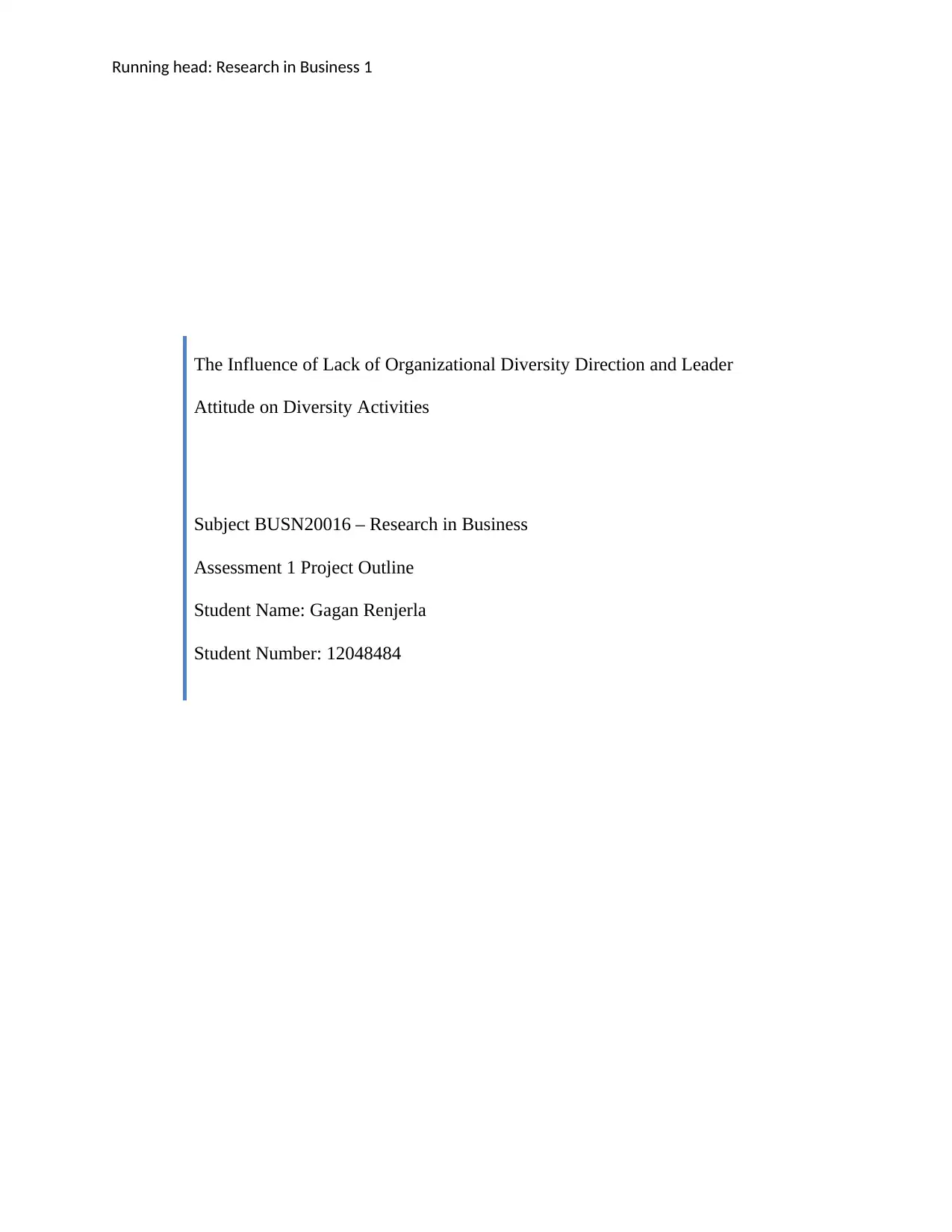
Running head: Research in Business 1
The Influence of Lack of Organizational Diversity Direction and Leader
Attitude on Diversity Activities
Subject BUSN20016 – Research in Business
Assessment 1 Project Outline
Student Name: Gagan Renjerla
Student Number: 12048484
The Influence of Lack of Organizational Diversity Direction and Leader
Attitude on Diversity Activities
Subject BUSN20016 – Research in Business
Assessment 1 Project Outline
Student Name: Gagan Renjerla
Student Number: 12048484
Paraphrase This Document
Need a fresh take? Get an instant paraphrase of this document with our AI Paraphraser
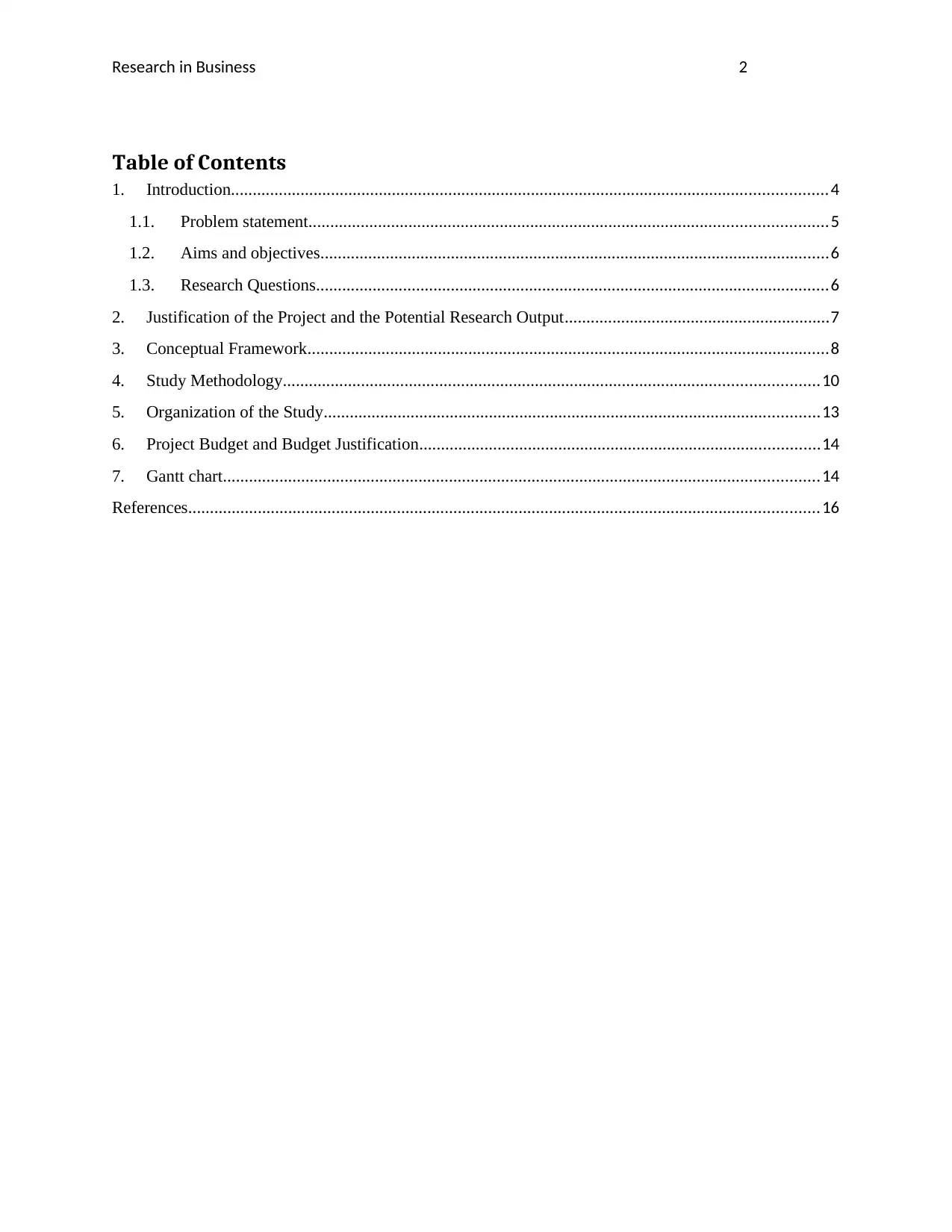
Research in Business 2
Table of Contents
1. Introduction.........................................................................................................................................4
1.1. Problem statement.......................................................................................................................5
1.2. Aims and objectives.....................................................................................................................6
1.3. Research Questions......................................................................................................................6
2. Justification of the Project and the Potential Research Output.............................................................7
3. Conceptual Framework........................................................................................................................8
4. Study Methodology...........................................................................................................................10
5. Organization of the Study..................................................................................................................13
6. Project Budget and Budget Justification............................................................................................14
7. Gantt chart.........................................................................................................................................14
References.................................................................................................................................................16
Table of Contents
1. Introduction.........................................................................................................................................4
1.1. Problem statement.......................................................................................................................5
1.2. Aims and objectives.....................................................................................................................6
1.3. Research Questions......................................................................................................................6
2. Justification of the Project and the Potential Research Output.............................................................7
3. Conceptual Framework........................................................................................................................8
4. Study Methodology...........................................................................................................................10
5. Organization of the Study..................................................................................................................13
6. Project Budget and Budget Justification............................................................................................14
7. Gantt chart.........................................................................................................................................14
References.................................................................................................................................................16
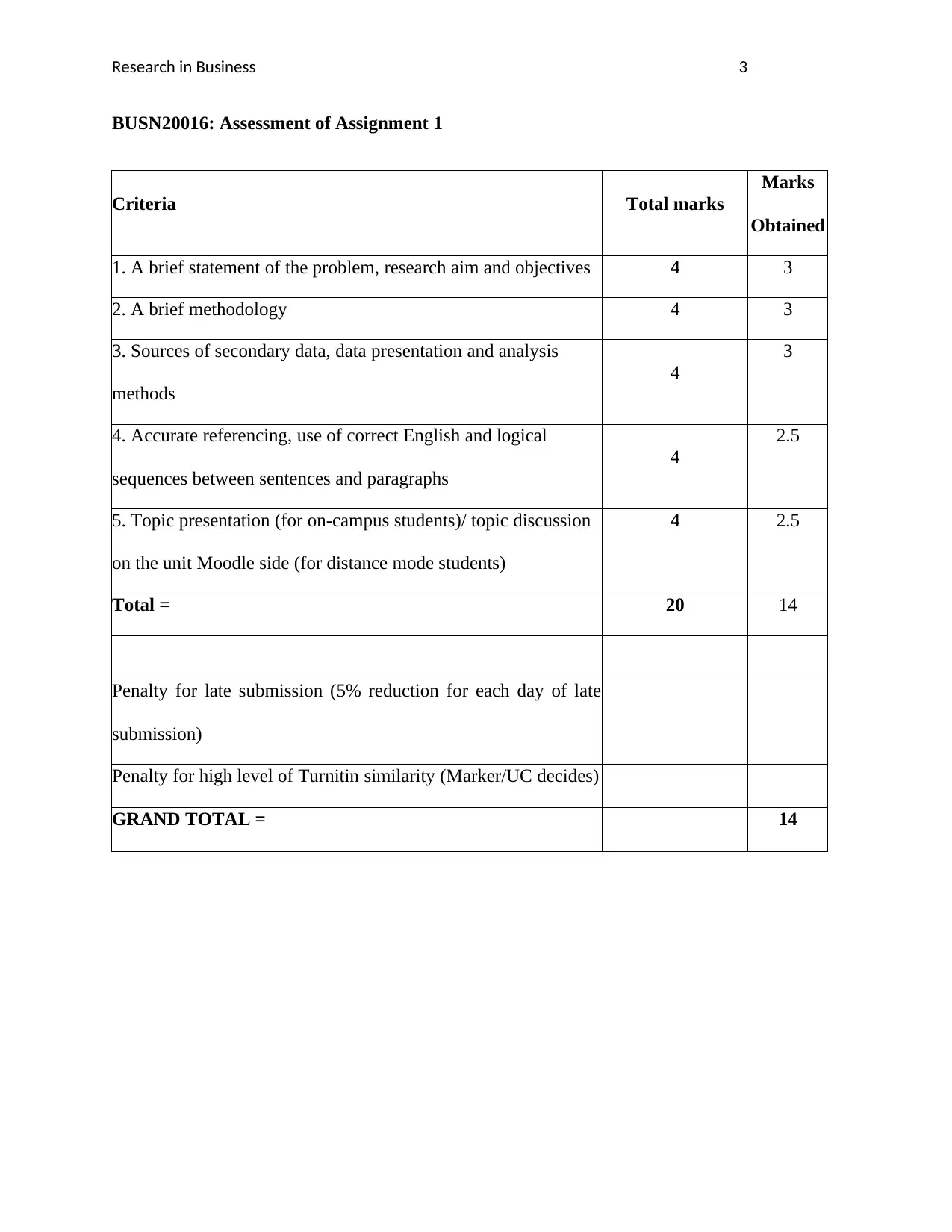
Research in Business 3
BUSN20016: Assessment of Assignment 1
Criteria Total marks
Marks
Obtained
1. A brief statement of the problem, research aim and objectives 4 3
2. A brief methodology 4 3
3. Sources of secondary data, data presentation and analysis
methods
4
3
4. Accurate referencing, use of correct English and logical
sequences between sentences and paragraphs
4
2.5
5. Topic presentation (for on-campus students)/ topic discussion
on the unit Moodle side (for distance mode students)
4 2.5
Total = 20 14
Penalty for late submission (5% reduction for each day of late
submission)
Penalty for high level of Turnitin similarity (Marker/UC decides)
GRAND TOTAL = 14
BUSN20016: Assessment of Assignment 1
Criteria Total marks
Marks
Obtained
1. A brief statement of the problem, research aim and objectives 4 3
2. A brief methodology 4 3
3. Sources of secondary data, data presentation and analysis
methods
4
3
4. Accurate referencing, use of correct English and logical
sequences between sentences and paragraphs
4
2.5
5. Topic presentation (for on-campus students)/ topic discussion
on the unit Moodle side (for distance mode students)
4 2.5
Total = 20 14
Penalty for late submission (5% reduction for each day of late
submission)
Penalty for high level of Turnitin similarity (Marker/UC decides)
GRAND TOTAL = 14
⊘ This is a preview!⊘
Do you want full access?
Subscribe today to unlock all pages.

Trusted by 1+ million students worldwide
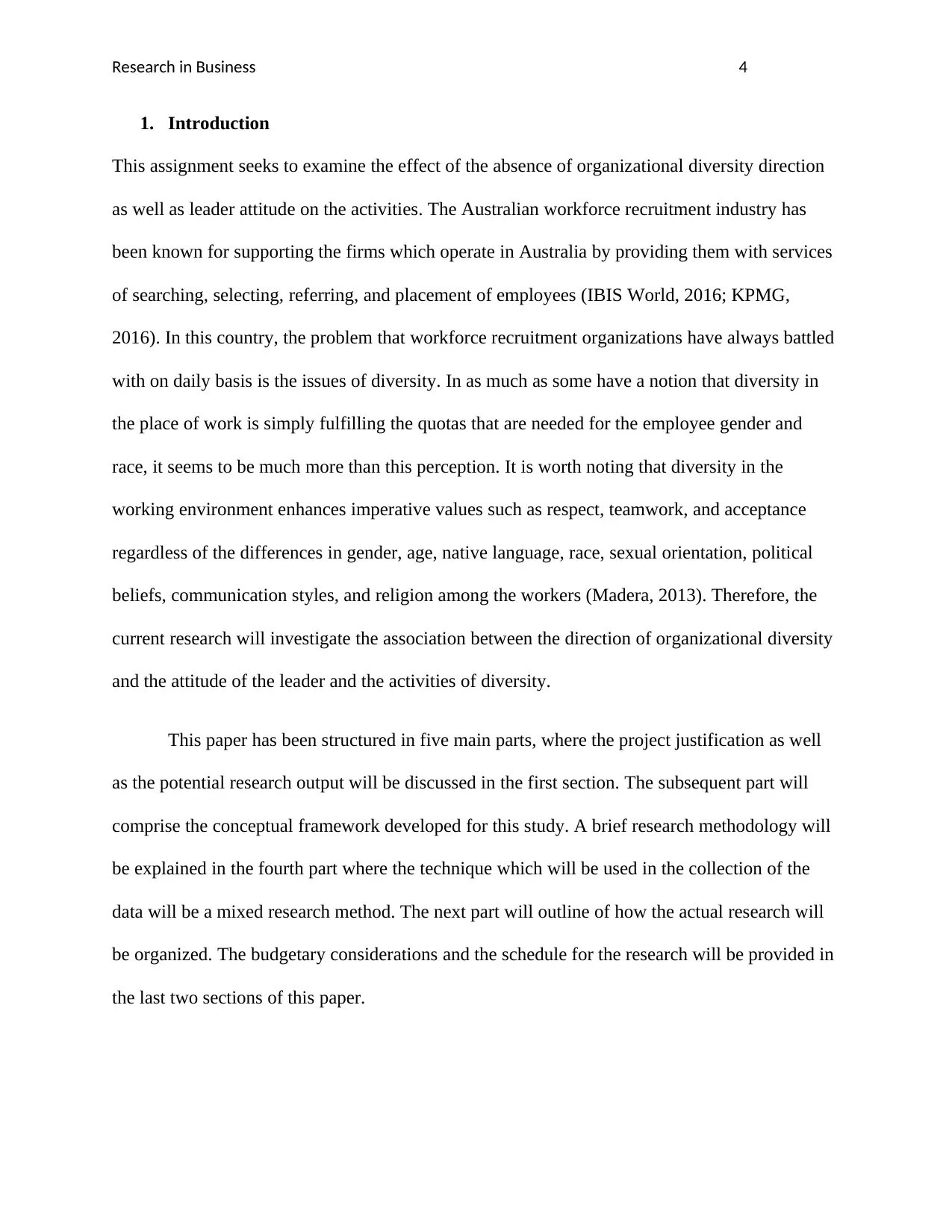
Research in Business 4
1. Introduction
This assignment seeks to examine the effect of the absence of organizational diversity direction
as well as leader attitude on the activities. The Australian workforce recruitment industry has
been known for supporting the firms which operate in Australia by providing them with services
of searching, selecting, referring, and placement of employees (IBIS World, 2016; KPMG,
2016). In this country, the problem that workforce recruitment organizations have always battled
with on daily basis is the issues of diversity. In as much as some have a notion that diversity in
the place of work is simply fulfilling the quotas that are needed for the employee gender and
race, it seems to be much more than this perception. It is worth noting that diversity in the
working environment enhances imperative values such as respect, teamwork, and acceptance
regardless of the differences in gender, age, native language, race, sexual orientation, political
beliefs, communication styles, and religion among the workers (Madera, 2013). Therefore, the
current research will investigate the association between the direction of organizational diversity
and the attitude of the leader and the activities of diversity.
This paper has been structured in five main parts, where the project justification as well
as the potential research output will be discussed in the first section. The subsequent part will
comprise the conceptual framework developed for this study. A brief research methodology will
be explained in the fourth part where the technique which will be used in the collection of the
data will be a mixed research method. The next part will outline of how the actual research will
be organized. The budgetary considerations and the schedule for the research will be provided in
the last two sections of this paper.
1. Introduction
This assignment seeks to examine the effect of the absence of organizational diversity direction
as well as leader attitude on the activities. The Australian workforce recruitment industry has
been known for supporting the firms which operate in Australia by providing them with services
of searching, selecting, referring, and placement of employees (IBIS World, 2016; KPMG,
2016). In this country, the problem that workforce recruitment organizations have always battled
with on daily basis is the issues of diversity. In as much as some have a notion that diversity in
the place of work is simply fulfilling the quotas that are needed for the employee gender and
race, it seems to be much more than this perception. It is worth noting that diversity in the
working environment enhances imperative values such as respect, teamwork, and acceptance
regardless of the differences in gender, age, native language, race, sexual orientation, political
beliefs, communication styles, and religion among the workers (Madera, 2013). Therefore, the
current research will investigate the association between the direction of organizational diversity
and the attitude of the leader and the activities of diversity.
This paper has been structured in five main parts, where the project justification as well
as the potential research output will be discussed in the first section. The subsequent part will
comprise the conceptual framework developed for this study. A brief research methodology will
be explained in the fourth part where the technique which will be used in the collection of the
data will be a mixed research method. The next part will outline of how the actual research will
be organized. The budgetary considerations and the schedule for the research will be provided in
the last two sections of this paper.
Paraphrase This Document
Need a fresh take? Get an instant paraphrase of this document with our AI Paraphraser
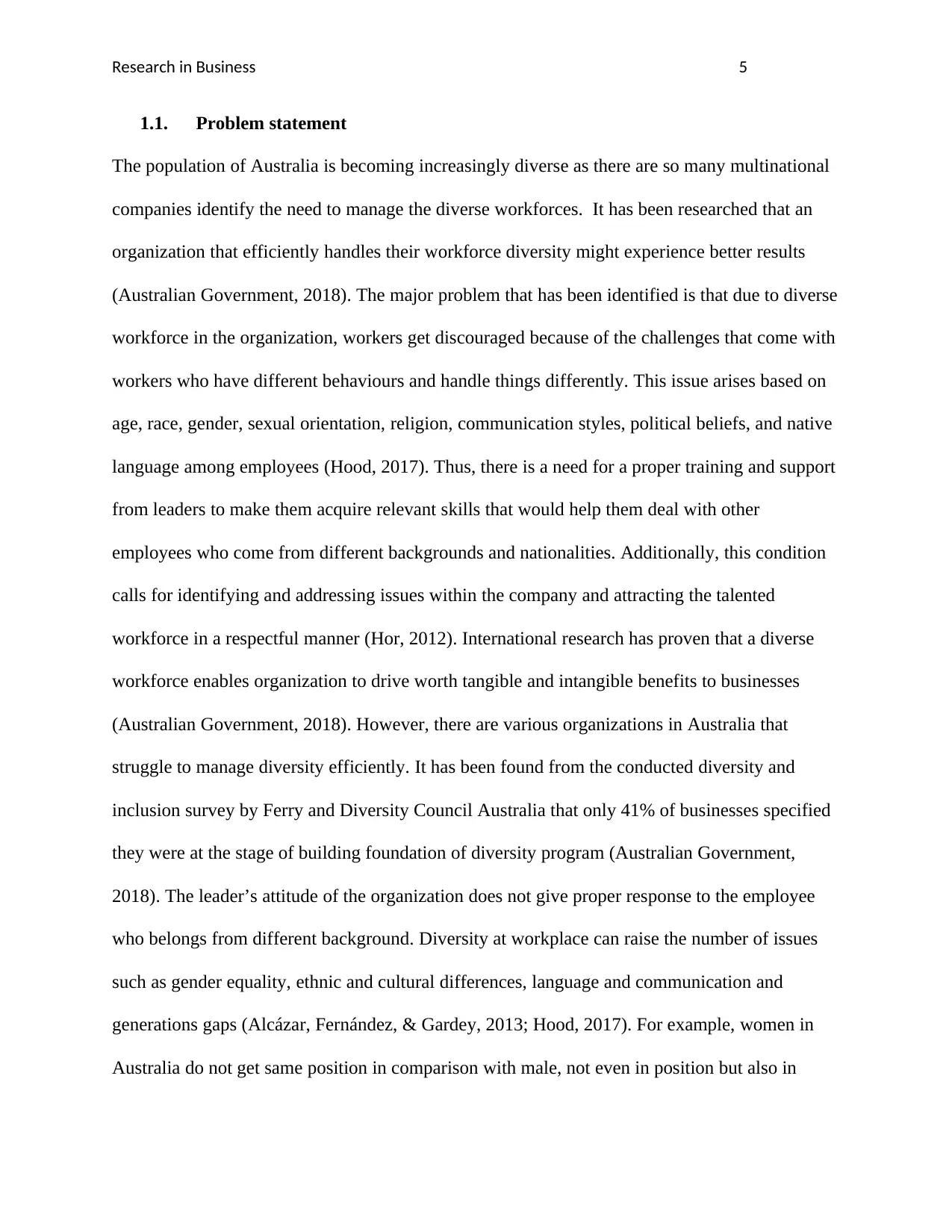
Research in Business 5
1.1. Problem statement
The population of Australia is becoming increasingly diverse as there are so many multinational
companies identify the need to manage the diverse workforces. It has been researched that an
organization that efficiently handles their workforce diversity might experience better results
(Australian Government, 2018). The major problem that has been identified is that due to diverse
workforce in the organization, workers get discouraged because of the challenges that come with
workers who have different behaviours and handle things differently. This issue arises based on
age, race, gender, sexual orientation, religion, communication styles, political beliefs, and native
language among employees (Hood, 2017). Thus, there is a need for a proper training and support
from leaders to make them acquire relevant skills that would help them deal with other
employees who come from different backgrounds and nationalities. Additionally, this condition
calls for identifying and addressing issues within the company and attracting the talented
workforce in a respectful manner (Hor, 2012). International research has proven that a diverse
workforce enables organization to drive worth tangible and intangible benefits to businesses
(Australian Government, 2018). However, there are various organizations in Australia that
struggle to manage diversity efficiently. It has been found from the conducted diversity and
inclusion survey by Ferry and Diversity Council Australia that only 41% of businesses specified
they were at the stage of building foundation of diversity program (Australian Government,
2018). The leader’s attitude of the organization does not give proper response to the employee
who belongs from different background. Diversity at workplace can raise the number of issues
such as gender equality, ethnic and cultural differences, language and communication and
generations gaps (Alcázar, Fernández, & Gardey, 2013; Hood, 2017). For example, women in
Australia do not get same position in comparison with male, not even in position but also in
1.1. Problem statement
The population of Australia is becoming increasingly diverse as there are so many multinational
companies identify the need to manage the diverse workforces. It has been researched that an
organization that efficiently handles their workforce diversity might experience better results
(Australian Government, 2018). The major problem that has been identified is that due to diverse
workforce in the organization, workers get discouraged because of the challenges that come with
workers who have different behaviours and handle things differently. This issue arises based on
age, race, gender, sexual orientation, religion, communication styles, political beliefs, and native
language among employees (Hood, 2017). Thus, there is a need for a proper training and support
from leaders to make them acquire relevant skills that would help them deal with other
employees who come from different backgrounds and nationalities. Additionally, this condition
calls for identifying and addressing issues within the company and attracting the talented
workforce in a respectful manner (Hor, 2012). International research has proven that a diverse
workforce enables organization to drive worth tangible and intangible benefits to businesses
(Australian Government, 2018). However, there are various organizations in Australia that
struggle to manage diversity efficiently. It has been found from the conducted diversity and
inclusion survey by Ferry and Diversity Council Australia that only 41% of businesses specified
they were at the stage of building foundation of diversity program (Australian Government,
2018). The leader’s attitude of the organization does not give proper response to the employee
who belongs from different background. Diversity at workplace can raise the number of issues
such as gender equality, ethnic and cultural differences, language and communication and
generations gaps (Alcázar, Fernández, & Gardey, 2013; Hood, 2017). For example, women in
Australia do not get same position in comparison with male, not even in position but also in
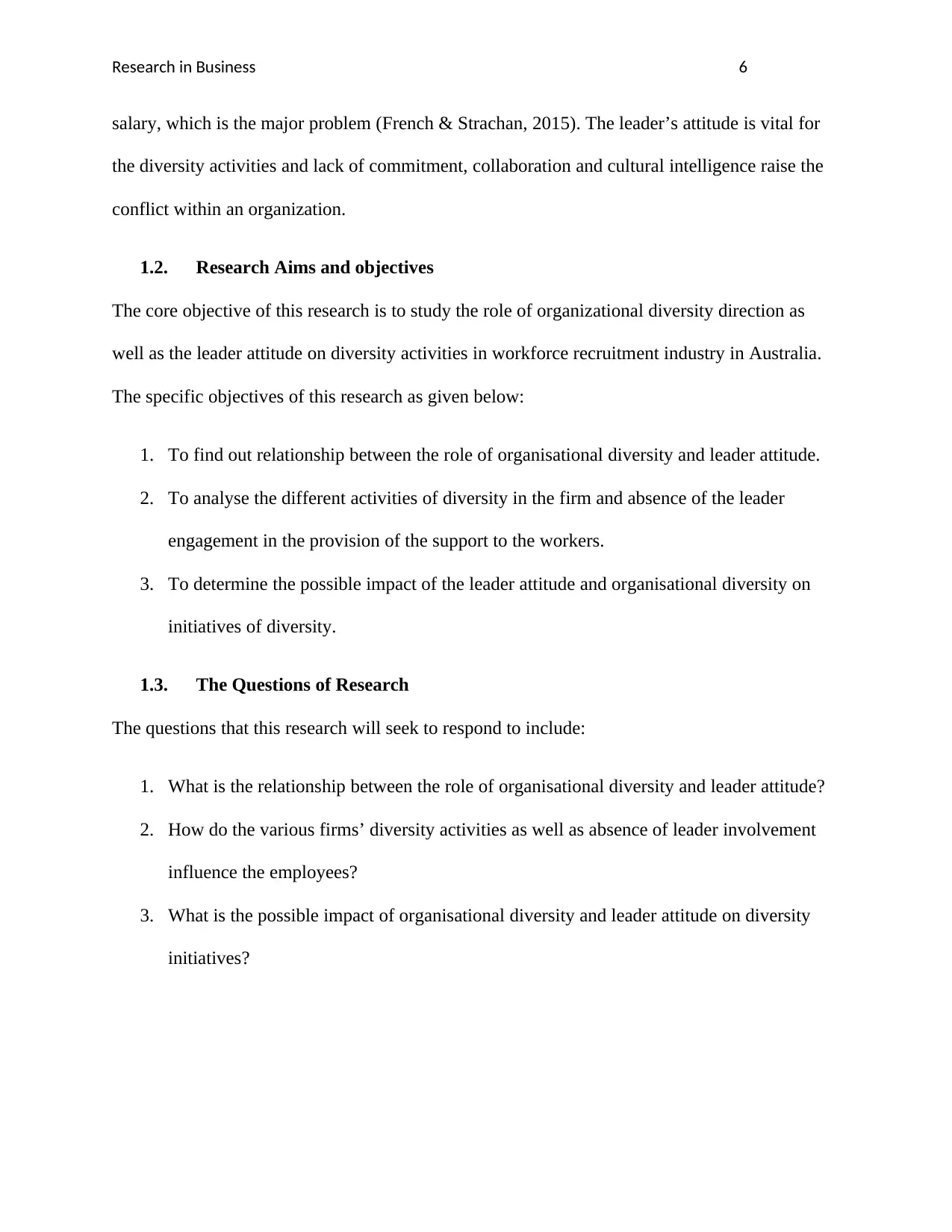
Research in Business 6
salary, which is the major problem (French & Strachan, 2015). The leader’s attitude is vital for
the diversity activities and lack of commitment, collaboration and cultural intelligence raise the
conflict within an organization.
1.2. Research Aims and objectives
The core objective of this research is to study the role of organizational diversity direction as
well as the leader attitude on diversity activities in workforce recruitment industry in Australia.
The specific objectives of this research as given below:
1. To find out relationship between the role of organisational diversity and leader attitude.
2. To analyse the different activities of diversity in the firm and absence of the leader
engagement in the provision of the support to the workers.
3. To determine the possible impact of the leader attitude and organisational diversity on
initiatives of diversity.
1.3. The Questions of Research
The questions that this research will seek to respond to include:
1. What is the relationship between the role of organisational diversity and leader attitude?
2. How do the various firms’ diversity activities as well as absence of leader involvement
influence the employees?
3. What is the possible impact of organisational diversity and leader attitude on diversity
initiatives?
salary, which is the major problem (French & Strachan, 2015). The leader’s attitude is vital for
the diversity activities and lack of commitment, collaboration and cultural intelligence raise the
conflict within an organization.
1.2. Research Aims and objectives
The core objective of this research is to study the role of organizational diversity direction as
well as the leader attitude on diversity activities in workforce recruitment industry in Australia.
The specific objectives of this research as given below:
1. To find out relationship between the role of organisational diversity and leader attitude.
2. To analyse the different activities of diversity in the firm and absence of the leader
engagement in the provision of the support to the workers.
3. To determine the possible impact of the leader attitude and organisational diversity on
initiatives of diversity.
1.3. The Questions of Research
The questions that this research will seek to respond to include:
1. What is the relationship between the role of organisational diversity and leader attitude?
2. How do the various firms’ diversity activities as well as absence of leader involvement
influence the employees?
3. What is the possible impact of organisational diversity and leader attitude on diversity
initiatives?
⊘ This is a preview!⊘
Do you want full access?
Subscribe today to unlock all pages.

Trusted by 1+ million students worldwide
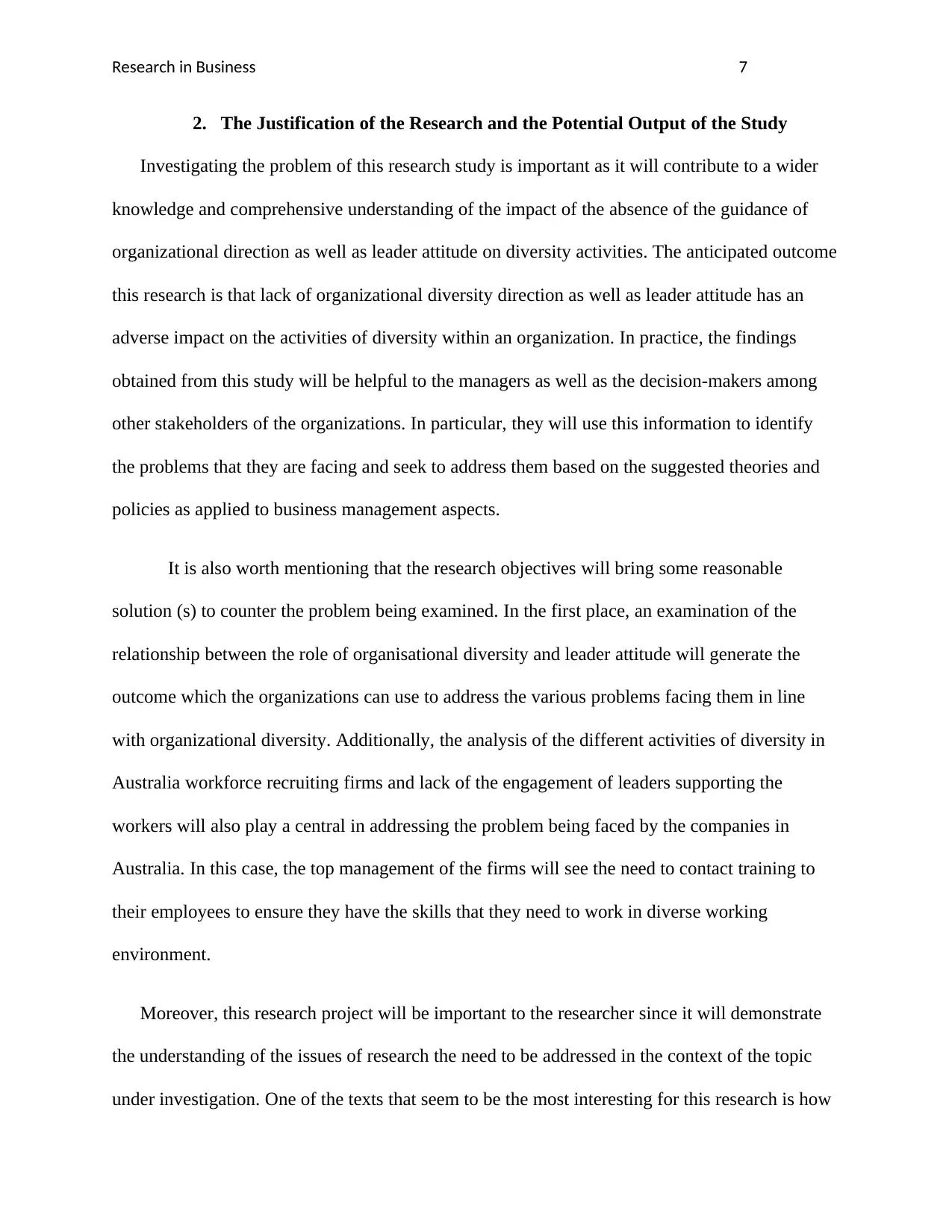
Research in Business 7
2. The Justification of the Research and the Potential Output of the Study
Investigating the problem of this research study is important as it will contribute to a wider
knowledge and comprehensive understanding of the impact of the absence of the guidance of
organizational direction as well as leader attitude on diversity activities. The anticipated outcome
this research is that lack of organizational diversity direction as well as leader attitude has an
adverse impact on the activities of diversity within an organization. In practice, the findings
obtained from this study will be helpful to the managers as well as the decision-makers among
other stakeholders of the organizations. In particular, they will use this information to identify
the problems that they are facing and seek to address them based on the suggested theories and
policies as applied to business management aspects.
It is also worth mentioning that the research objectives will bring some reasonable
solution (s) to counter the problem being examined. In the first place, an examination of the
relationship between the role of organisational diversity and leader attitude will generate the
outcome which the organizations can use to address the various problems facing them in line
with organizational diversity. Additionally, the analysis of the different activities of diversity in
Australia workforce recruiting firms and lack of the engagement of leaders supporting the
workers will also play a central in addressing the problem being faced by the companies in
Australia. In this case, the top management of the firms will see the need to contact training to
their employees to ensure they have the skills that they need to work in diverse working
environment.
Moreover, this research project will be important to the researcher since it will demonstrate
the understanding of the issues of research the need to be addressed in the context of the topic
under investigation. One of the texts that seem to be the most interesting for this research is how
2. The Justification of the Research and the Potential Output of the Study
Investigating the problem of this research study is important as it will contribute to a wider
knowledge and comprehensive understanding of the impact of the absence of the guidance of
organizational direction as well as leader attitude on diversity activities. The anticipated outcome
this research is that lack of organizational diversity direction as well as leader attitude has an
adverse impact on the activities of diversity within an organization. In practice, the findings
obtained from this study will be helpful to the managers as well as the decision-makers among
other stakeholders of the organizations. In particular, they will use this information to identify
the problems that they are facing and seek to address them based on the suggested theories and
policies as applied to business management aspects.
It is also worth mentioning that the research objectives will bring some reasonable
solution (s) to counter the problem being examined. In the first place, an examination of the
relationship between the role of organisational diversity and leader attitude will generate the
outcome which the organizations can use to address the various problems facing them in line
with organizational diversity. Additionally, the analysis of the different activities of diversity in
Australia workforce recruiting firms and lack of the engagement of leaders supporting the
workers will also play a central in addressing the problem being faced by the companies in
Australia. In this case, the top management of the firms will see the need to contact training to
their employees to ensure they have the skills that they need to work in diverse working
environment.
Moreover, this research project will be important to the researcher since it will demonstrate
the understanding of the issues of research the need to be addressed in the context of the topic
under investigation. One of the texts that seem to be the most interesting for this research is how
Paraphrase This Document
Need a fresh take? Get an instant paraphrase of this document with our AI Paraphraser
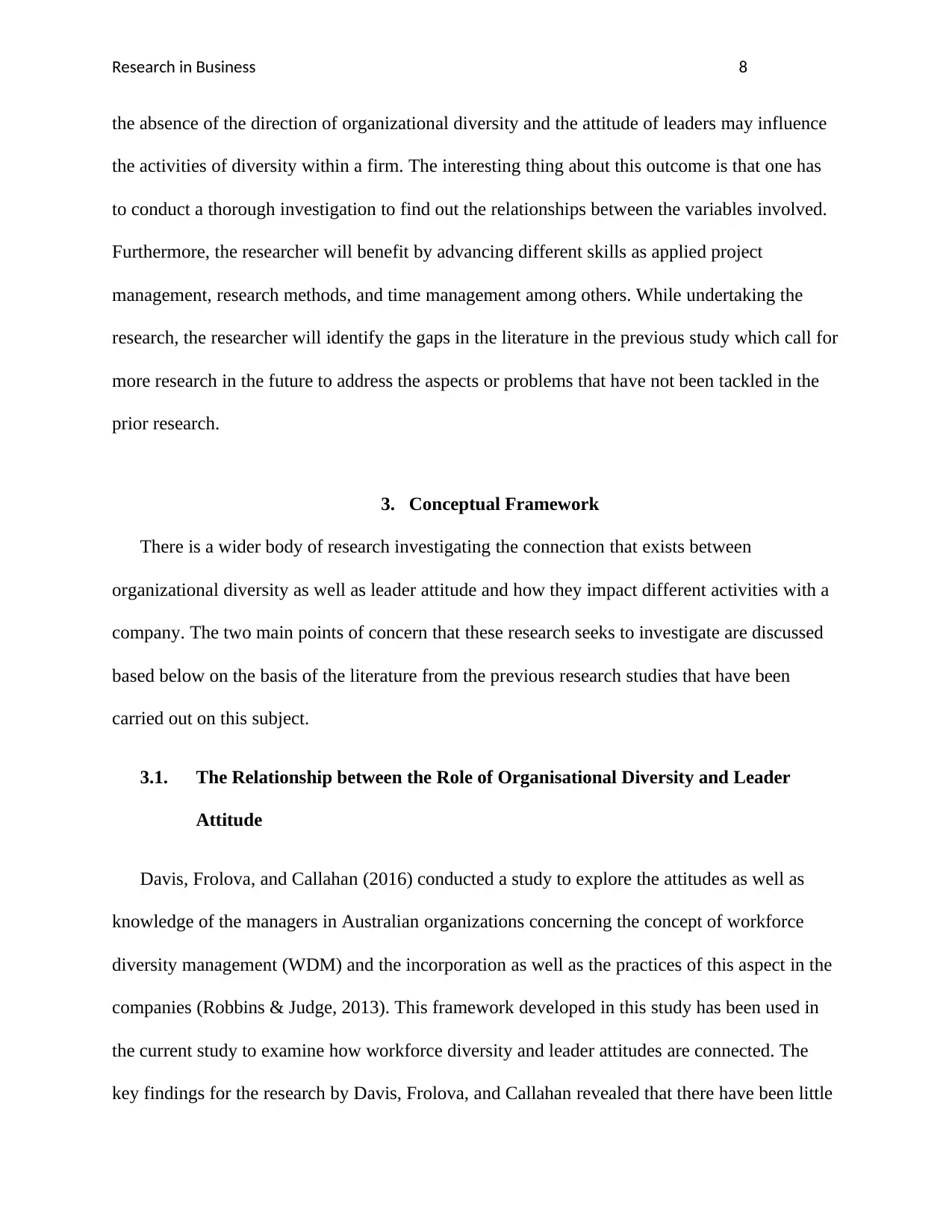
Research in Business 8
the absence of the direction of organizational diversity and the attitude of leaders may influence
the activities of diversity within a firm. The interesting thing about this outcome is that one has
to conduct a thorough investigation to find out the relationships between the variables involved.
Furthermore, the researcher will benefit by advancing different skills as applied project
management, research methods, and time management among others. While undertaking the
research, the researcher will identify the gaps in the literature in the previous study which call for
more research in the future to address the aspects or problems that have not been tackled in the
prior research.
3. Conceptual Framework
There is a wider body of research investigating the connection that exists between
organizational diversity as well as leader attitude and how they impact different activities with a
company. The two main points of concern that these research seeks to investigate are discussed
based below on the basis of the literature from the previous research studies that have been
carried out on this subject.
3.1. The Relationship between the Role of Organisational Diversity and Leader
Attitude
Davis, Frolova, and Callahan (2016) conducted a study to explore the attitudes as well as
knowledge of the managers in Australian organizations concerning the concept of workforce
diversity management (WDM) and the incorporation as well as the practices of this aspect in the
companies (Robbins & Judge, 2013). This framework developed in this study has been used in
the current study to examine how workforce diversity and leader attitudes are connected. The
key findings for the research by Davis, Frolova, and Callahan revealed that there have been little
the absence of the direction of organizational diversity and the attitude of leaders may influence
the activities of diversity within a firm. The interesting thing about this outcome is that one has
to conduct a thorough investigation to find out the relationships between the variables involved.
Furthermore, the researcher will benefit by advancing different skills as applied project
management, research methods, and time management among others. While undertaking the
research, the researcher will identify the gaps in the literature in the previous study which call for
more research in the future to address the aspects or problems that have not been tackled in the
prior research.
3. Conceptual Framework
There is a wider body of research investigating the connection that exists between
organizational diversity as well as leader attitude and how they impact different activities with a
company. The two main points of concern that these research seeks to investigate are discussed
based below on the basis of the literature from the previous research studies that have been
carried out on this subject.
3.1. The Relationship between the Role of Organisational Diversity and Leader
Attitude
Davis, Frolova, and Callahan (2016) conducted a study to explore the attitudes as well as
knowledge of the managers in Australian organizations concerning the concept of workforce
diversity management (WDM) and the incorporation as well as the practices of this aspect in the
companies (Robbins & Judge, 2013). This framework developed in this study has been used in
the current study to examine how workforce diversity and leader attitudes are connected. The
key findings for the research by Davis, Frolova, and Callahan revealed that there have been little
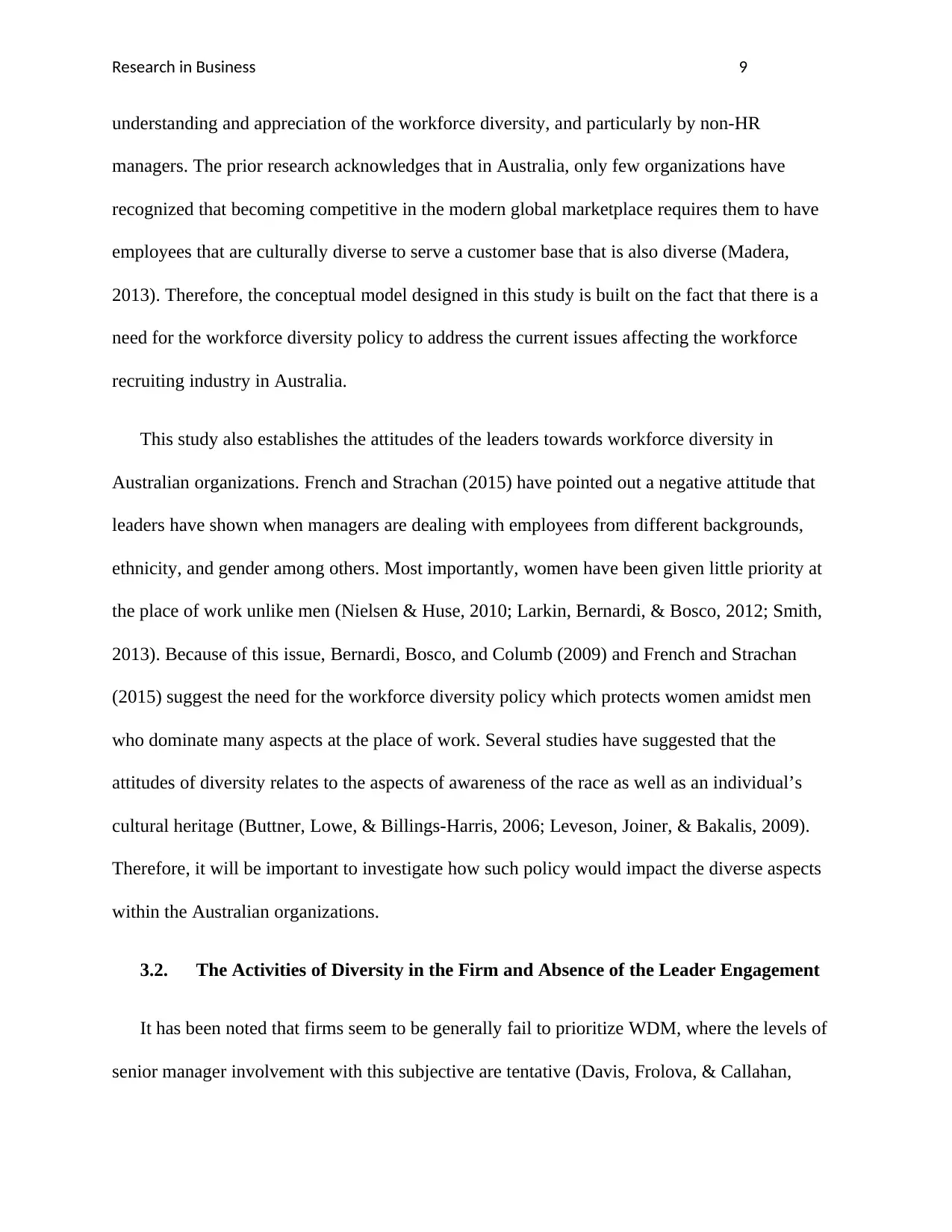
Research in Business 9
understanding and appreciation of the workforce diversity, and particularly by non-HR
managers. The prior research acknowledges that in Australia, only few organizations have
recognized that becoming competitive in the modern global marketplace requires them to have
employees that are culturally diverse to serve a customer base that is also diverse (Madera,
2013). Therefore, the conceptual model designed in this study is built on the fact that there is a
need for the workforce diversity policy to address the current issues affecting the workforce
recruiting industry in Australia.
This study also establishes the attitudes of the leaders towards workforce diversity in
Australian organizations. French and Strachan (2015) have pointed out a negative attitude that
leaders have shown when managers are dealing with employees from different backgrounds,
ethnicity, and gender among others. Most importantly, women have been given little priority at
the place of work unlike men (Nielsen & Huse, 2010; Larkin, Bernardi, & Bosco, 2012; Smith,
2013). Because of this issue, Bernardi, Bosco, and Columb (2009) and French and Strachan
(2015) suggest the need for the workforce diversity policy which protects women amidst men
who dominate many aspects at the place of work. Several studies have suggested that the
attitudes of diversity relates to the aspects of awareness of the race as well as an individual’s
cultural heritage (Buttner, Lowe, & Billings-Harris, 2006; Leveson, Joiner, & Bakalis, 2009).
Therefore, it will be important to investigate how such policy would impact the diverse aspects
within the Australian organizations.
3.2. The Activities of Diversity in the Firm and Absence of the Leader Engagement
It has been noted that firms seem to be generally fail to prioritize WDM, where the levels of
senior manager involvement with this subjective are tentative (Davis, Frolova, & Callahan,
understanding and appreciation of the workforce diversity, and particularly by non-HR
managers. The prior research acknowledges that in Australia, only few organizations have
recognized that becoming competitive in the modern global marketplace requires them to have
employees that are culturally diverse to serve a customer base that is also diverse (Madera,
2013). Therefore, the conceptual model designed in this study is built on the fact that there is a
need for the workforce diversity policy to address the current issues affecting the workforce
recruiting industry in Australia.
This study also establishes the attitudes of the leaders towards workforce diversity in
Australian organizations. French and Strachan (2015) have pointed out a negative attitude that
leaders have shown when managers are dealing with employees from different backgrounds,
ethnicity, and gender among others. Most importantly, women have been given little priority at
the place of work unlike men (Nielsen & Huse, 2010; Larkin, Bernardi, & Bosco, 2012; Smith,
2013). Because of this issue, Bernardi, Bosco, and Columb (2009) and French and Strachan
(2015) suggest the need for the workforce diversity policy which protects women amidst men
who dominate many aspects at the place of work. Several studies have suggested that the
attitudes of diversity relates to the aspects of awareness of the race as well as an individual’s
cultural heritage (Buttner, Lowe, & Billings-Harris, 2006; Leveson, Joiner, & Bakalis, 2009).
Therefore, it will be important to investigate how such policy would impact the diverse aspects
within the Australian organizations.
3.2. The Activities of Diversity in the Firm and Absence of the Leader Engagement
It has been noted that firms seem to be generally fail to prioritize WDM, where the levels of
senior manager involvement with this subjective are tentative (Davis, Frolova, & Callahan,
⊘ This is a preview!⊘
Do you want full access?
Subscribe today to unlock all pages.

Trusted by 1+ million students worldwide
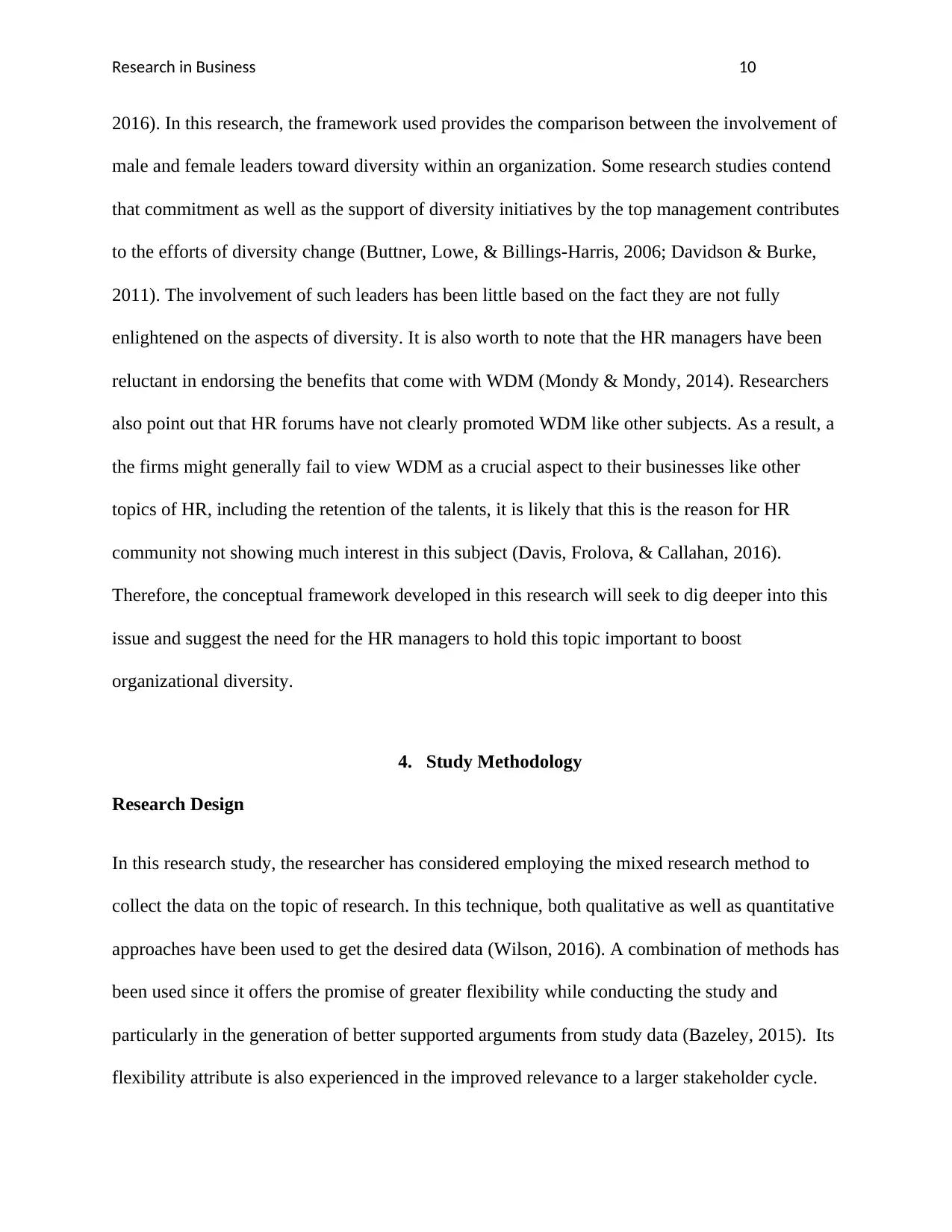
Research in Business 10
2016). In this research, the framework used provides the comparison between the involvement of
male and female leaders toward diversity within an organization. Some research studies contend
that commitment as well as the support of diversity initiatives by the top management contributes
to the efforts of diversity change (Buttner, Lowe, & Billings-Harris, 2006; Davidson & Burke,
2011). The involvement of such leaders has been little based on the fact they are not fully
enlightened on the aspects of diversity. It is also worth to note that the HR managers have been
reluctant in endorsing the benefits that come with WDM (Mondy & Mondy, 2014). Researchers
also point out that HR forums have not clearly promoted WDM like other subjects. As a result, a
the firms might generally fail to view WDM as a crucial aspect to their businesses like other
topics of HR, including the retention of the talents, it is likely that this is the reason for HR
community not showing much interest in this subject (Davis, Frolova, & Callahan, 2016).
Therefore, the conceptual framework developed in this research will seek to dig deeper into this
issue and suggest the need for the HR managers to hold this topic important to boost
organizational diversity.
4. Study Methodology
Research Design
In this research study, the researcher has considered employing the mixed research method to
collect the data on the topic of research. In this technique, both qualitative as well as quantitative
approaches have been used to get the desired data (Wilson, 2016). A combination of methods has
been used since it offers the promise of greater flexibility while conducting the study and
particularly in the generation of better supported arguments from study data (Bazeley, 2015). Its
flexibility attribute is also experienced in the improved relevance to a larger stakeholder cycle.
2016). In this research, the framework used provides the comparison between the involvement of
male and female leaders toward diversity within an organization. Some research studies contend
that commitment as well as the support of diversity initiatives by the top management contributes
to the efforts of diversity change (Buttner, Lowe, & Billings-Harris, 2006; Davidson & Burke,
2011). The involvement of such leaders has been little based on the fact they are not fully
enlightened on the aspects of diversity. It is also worth to note that the HR managers have been
reluctant in endorsing the benefits that come with WDM (Mondy & Mondy, 2014). Researchers
also point out that HR forums have not clearly promoted WDM like other subjects. As a result, a
the firms might generally fail to view WDM as a crucial aspect to their businesses like other
topics of HR, including the retention of the talents, it is likely that this is the reason for HR
community not showing much interest in this subject (Davis, Frolova, & Callahan, 2016).
Therefore, the conceptual framework developed in this research will seek to dig deeper into this
issue and suggest the need for the HR managers to hold this topic important to boost
organizational diversity.
4. Study Methodology
Research Design
In this research study, the researcher has considered employing the mixed research method to
collect the data on the topic of research. In this technique, both qualitative as well as quantitative
approaches have been used to get the desired data (Wilson, 2016). A combination of methods has
been used since it offers the promise of greater flexibility while conducting the study and
particularly in the generation of better supported arguments from study data (Bazeley, 2015). Its
flexibility attribute is also experienced in the improved relevance to a larger stakeholder cycle.
Paraphrase This Document
Need a fresh take? Get an instant paraphrase of this document with our AI Paraphraser
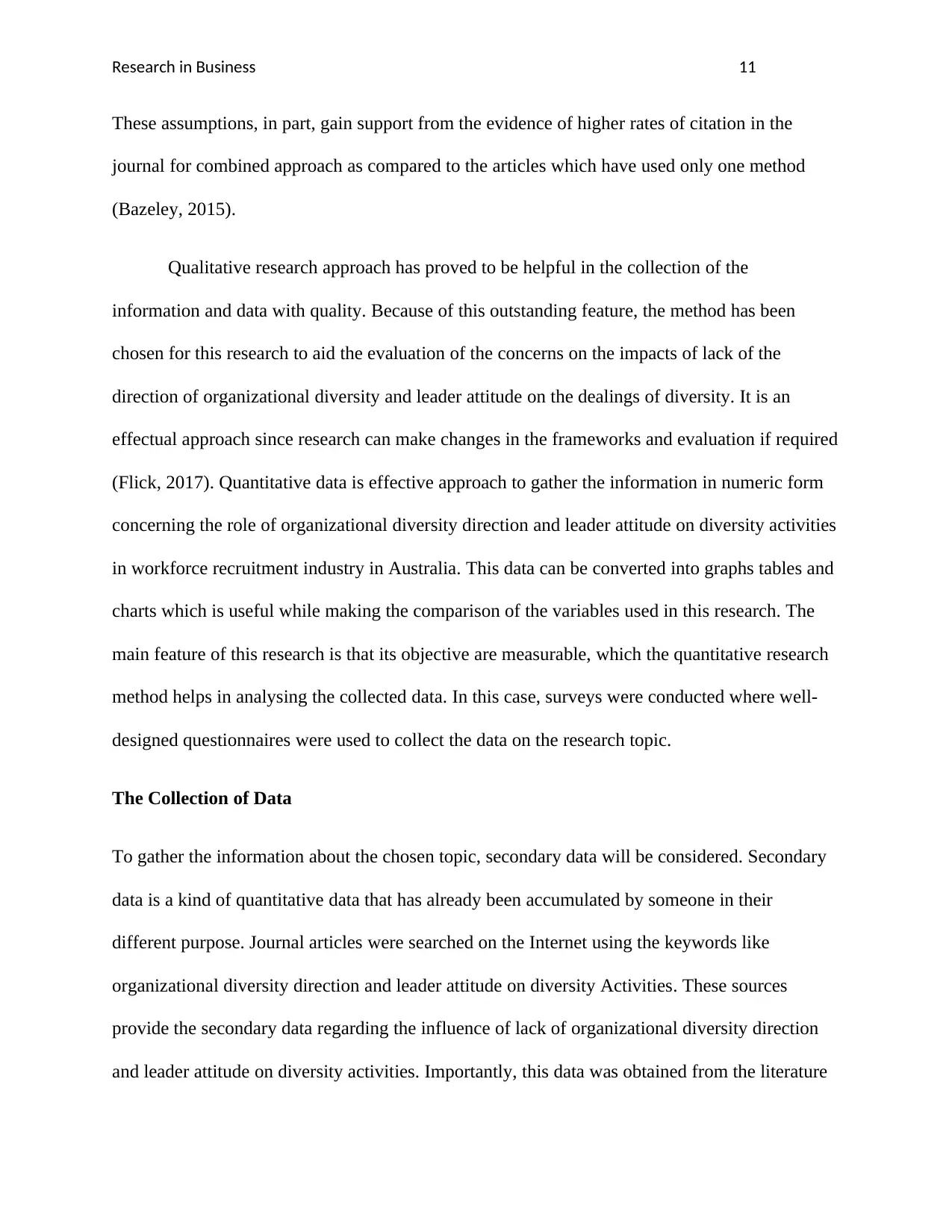
Research in Business 11
These assumptions, in part, gain support from the evidence of higher rates of citation in the
journal for combined approach as compared to the articles which have used only one method
(Bazeley, 2015).
Qualitative research approach has proved to be helpful in the collection of the
information and data with quality. Because of this outstanding feature, the method has been
chosen for this research to aid the evaluation of the concerns on the impacts of lack of the
direction of organizational diversity and leader attitude on the dealings of diversity. It is an
effectual approach since research can make changes in the frameworks and evaluation if required
(Flick, 2017). Quantitative data is effective approach to gather the information in numeric form
concerning the role of organizational diversity direction and leader attitude on diversity activities
in workforce recruitment industry in Australia. This data can be converted into graphs tables and
charts which is useful while making the comparison of the variables used in this research. The
main feature of this research is that its objective are measurable, which the quantitative research
method helps in analysing the collected data. In this case, surveys were conducted where well-
designed questionnaires were used to collect the data on the research topic.
The Collection of Data
To gather the information about the chosen topic, secondary data will be considered. Secondary
data is a kind of quantitative data that has already been accumulated by someone in their
different purpose. Journal articles were searched on the Internet using the keywords like
organizational diversity direction and leader attitude on diversity Activities. These sources
provide the secondary data regarding the influence of lack of organizational diversity direction
and leader attitude on diversity activities. Importantly, this data was obtained from the literature
These assumptions, in part, gain support from the evidence of higher rates of citation in the
journal for combined approach as compared to the articles which have used only one method
(Bazeley, 2015).
Qualitative research approach has proved to be helpful in the collection of the
information and data with quality. Because of this outstanding feature, the method has been
chosen for this research to aid the evaluation of the concerns on the impacts of lack of the
direction of organizational diversity and leader attitude on the dealings of diversity. It is an
effectual approach since research can make changes in the frameworks and evaluation if required
(Flick, 2017). Quantitative data is effective approach to gather the information in numeric form
concerning the role of organizational diversity direction and leader attitude on diversity activities
in workforce recruitment industry in Australia. This data can be converted into graphs tables and
charts which is useful while making the comparison of the variables used in this research. The
main feature of this research is that its objective are measurable, which the quantitative research
method helps in analysing the collected data. In this case, surveys were conducted where well-
designed questionnaires were used to collect the data on the research topic.
The Collection of Data
To gather the information about the chosen topic, secondary data will be considered. Secondary
data is a kind of quantitative data that has already been accumulated by someone in their
different purpose. Journal articles were searched on the Internet using the keywords like
organizational diversity direction and leader attitude on diversity Activities. These sources
provide the secondary data regarding the influence of lack of organizational diversity direction
and leader attitude on diversity activities. Importantly, this data was obtained from the literature
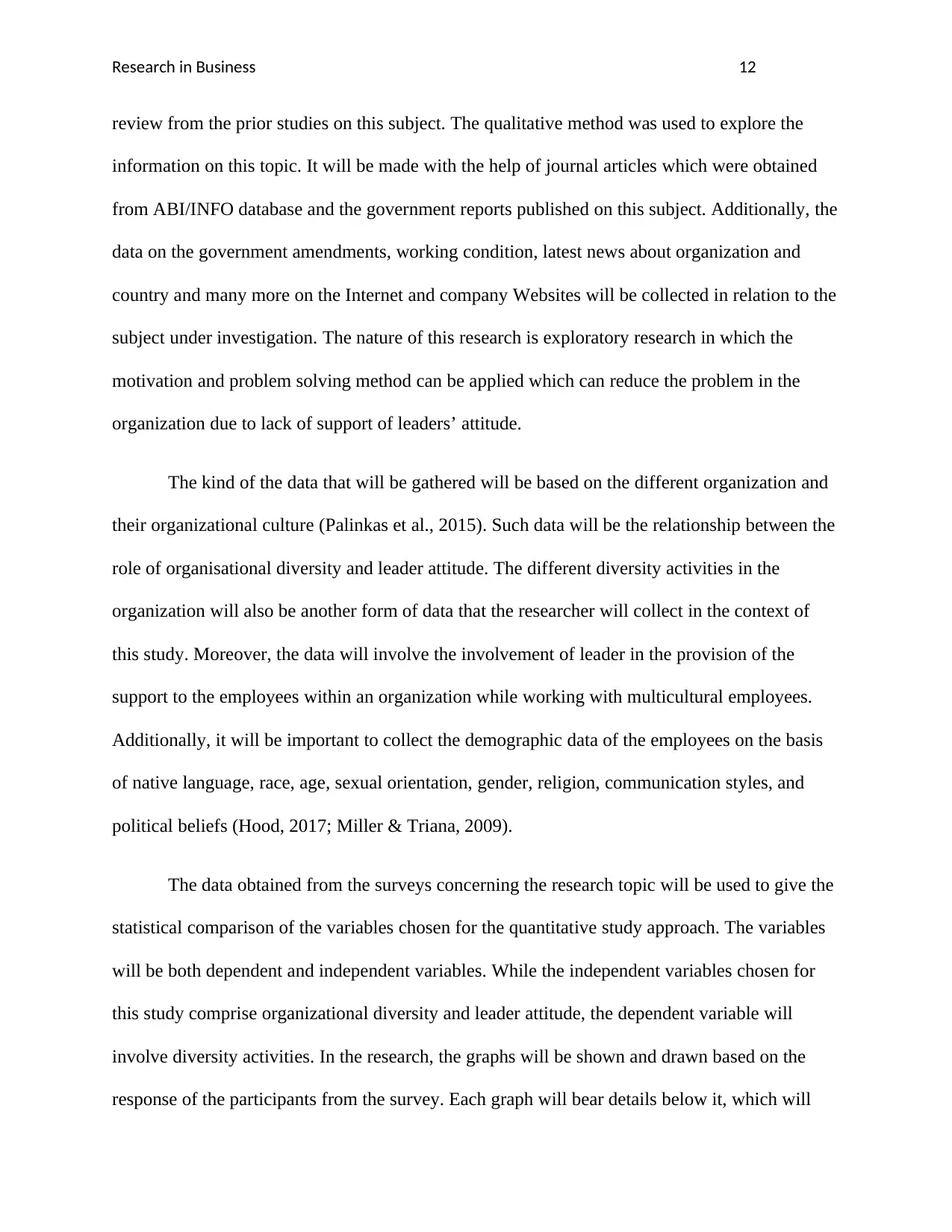
Research in Business 12
review from the prior studies on this subject. The qualitative method was used to explore the
information on this topic. It will be made with the help of journal articles which were obtained
from ABI/INFO database and the government reports published on this subject. Additionally, the
data on the government amendments, working condition, latest news about organization and
country and many more on the Internet and company Websites will be collected in relation to the
subject under investigation. The nature of this research is exploratory research in which the
motivation and problem solving method can be applied which can reduce the problem in the
organization due to lack of support of leaders’ attitude.
The kind of the data that will be gathered will be based on the different organization and
their organizational culture (Palinkas et al., 2015). Such data will be the relationship between the
role of organisational diversity and leader attitude. The different diversity activities in the
organization will also be another form of data that the researcher will collect in the context of
this study. Moreover, the data will involve the involvement of leader in the provision of the
support to the employees within an organization while working with multicultural employees.
Additionally, it will be important to collect the demographic data of the employees on the basis
of native language, race, age, sexual orientation, gender, religion, communication styles, and
political beliefs (Hood, 2017; Miller & Triana, 2009).
The data obtained from the surveys concerning the research topic will be used to give the
statistical comparison of the variables chosen for the quantitative study approach. The variables
will be both dependent and independent variables. While the independent variables chosen for
this study comprise organizational diversity and leader attitude, the dependent variable will
involve diversity activities. In the research, the graphs will be shown and drawn based on the
response of the participants from the survey. Each graph will bear details below it, which will
review from the prior studies on this subject. The qualitative method was used to explore the
information on this topic. It will be made with the help of journal articles which were obtained
from ABI/INFO database and the government reports published on this subject. Additionally, the
data on the government amendments, working condition, latest news about organization and
country and many more on the Internet and company Websites will be collected in relation to the
subject under investigation. The nature of this research is exploratory research in which the
motivation and problem solving method can be applied which can reduce the problem in the
organization due to lack of support of leaders’ attitude.
The kind of the data that will be gathered will be based on the different organization and
their organizational culture (Palinkas et al., 2015). Such data will be the relationship between the
role of organisational diversity and leader attitude. The different diversity activities in the
organization will also be another form of data that the researcher will collect in the context of
this study. Moreover, the data will involve the involvement of leader in the provision of the
support to the employees within an organization while working with multicultural employees.
Additionally, it will be important to collect the demographic data of the employees on the basis
of native language, race, age, sexual orientation, gender, religion, communication styles, and
political beliefs (Hood, 2017; Miller & Triana, 2009).
The data obtained from the surveys concerning the research topic will be used to give the
statistical comparison of the variables chosen for the quantitative study approach. The variables
will be both dependent and independent variables. While the independent variables chosen for
this study comprise organizational diversity and leader attitude, the dependent variable will
involve diversity activities. In the research, the graphs will be shown and drawn based on the
response of the participants from the survey. Each graph will bear details below it, which will
⊘ This is a preview!⊘
Do you want full access?
Subscribe today to unlock all pages.

Trusted by 1+ million students worldwide
1 out of 19
Related Documents
Your All-in-One AI-Powered Toolkit for Academic Success.
+13062052269
info@desklib.com
Available 24*7 on WhatsApp / Email
![[object Object]](/_next/static/media/star-bottom.7253800d.svg)
Unlock your academic potential
Copyright © 2020–2025 A2Z Services. All Rights Reserved. Developed and managed by ZUCOL.




